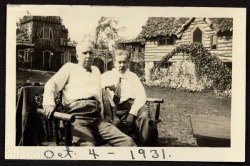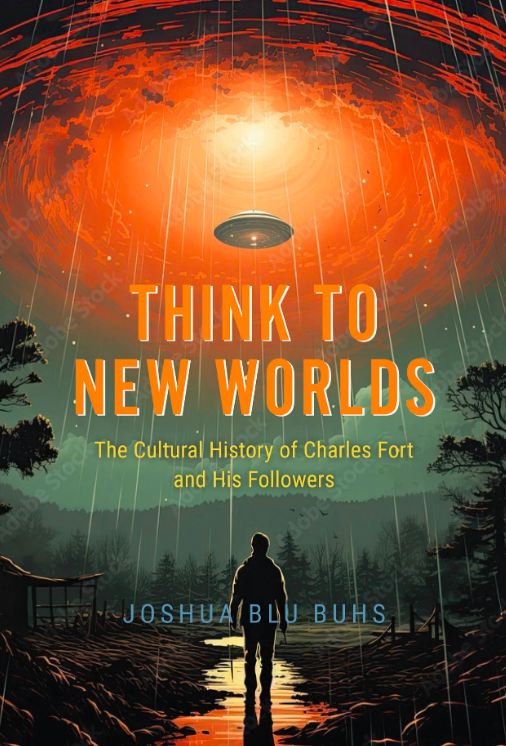THINK TO NEW WORLDS: THE CULTURAL HISTORY OF CHARLES FORT AND HIS FOLLOWERS
June 2024 will see the University of Chicago Press releasing my book on the Forteans. Details can be found here.
How a writer who investigated scientific anomalies inspired a factious movement and made a lasting impact on American culture.
Flying saucers. Bigfoot. Frogs raining from the sky. Such phenomena fascinated Charles Fort, the maverick writer who scanned newspapers, journals, and magazines for reports of bizarre occurrences: dogs that talked, vampires, strange visions in the sky, and paranormal activity. His books of anomalies advanced a philosophy that saw science as a small part of a larger system in which truth and falsehood continually transformed into one another. His work found a ragged following of skeptics who questioned not only science but the press, medicine, and politics. Though their worldviews varied, they shared compelling questions about genius, reality, and authority. At the center of this community was ad man, writer, and enfant terrible Tiffany Thayer, who founded the Fortean Society and ran it for almost three decades, collecting and reporting on every manner of oddity and conspiracy.
In Think to New Worlds, Joshua Blu Buhs argues that the Fortean effect on modern culture is deeper than you think. Fort’s descendants provided tools to expand the imagination, explore the social order, and demonstrate how power was exercised. Science fiction writers put these ideas to work as they sought to uncover the hidden structures undergirding reality. Avant-garde modernists—including the authors William Gaddis, Henry Miller, and Ezra Pound, as well as Surrealist visual artists—were inspired by Fort’s writing about metaphysical and historical forces. And in the years following World War II, flying saucer enthusiasts convinced of alien life raised questions about who controlled the universe.
Buhs’s meticulous and entertaining book takes a respectful look at a cast of oddballs and eccentrics, plucking them from history’s margins and spotlighting their mark on American modernism. Think to New Worlds is a timely consideration of a group united not only by conspiracies and mistrust of science but by their place in an ever-expanding universe rich with unexplained occurrences and visionary possibilities.
384 pages | 10 halftones | 6 x 9
History: AMERICAN HISTORY
HISTORY OF SCIENCE
Religion: RELIGION AND SOCIETY
How a writer who investigated scientific anomalies inspired a factious movement and made a lasting impact on American culture.
Flying saucers. Bigfoot. Frogs raining from the sky. Such phenomena fascinated Charles Fort, the maverick writer who scanned newspapers, journals, and magazines for reports of bizarre occurrences: dogs that talked, vampires, strange visions in the sky, and paranormal activity. His books of anomalies advanced a philosophy that saw science as a small part of a larger system in which truth and falsehood continually transformed into one another. His work found a ragged following of skeptics who questioned not only science but the press, medicine, and politics. Though their worldviews varied, they shared compelling questions about genius, reality, and authority. At the center of this community was ad man, writer, and enfant terrible Tiffany Thayer, who founded the Fortean Society and ran it for almost three decades, collecting and reporting on every manner of oddity and conspiracy.
In Think to New Worlds, Joshua Blu Buhs argues that the Fortean effect on modern culture is deeper than you think. Fort’s descendants provided tools to expand the imagination, explore the social order, and demonstrate how power was exercised. Science fiction writers put these ideas to work as they sought to uncover the hidden structures undergirding reality. Avant-garde modernists—including the authors William Gaddis, Henry Miller, and Ezra Pound, as well as Surrealist visual artists—were inspired by Fort’s writing about metaphysical and historical forces. And in the years following World War II, flying saucer enthusiasts convinced of alien life raised questions about who controlled the universe.
Buhs’s meticulous and entertaining book takes a respectful look at a cast of oddballs and eccentrics, plucking them from history’s margins and spotlighting their mark on American modernism. Think to New Worlds is a timely consideration of a group united not only by conspiracies and mistrust of science but by their place in an ever-expanding universe rich with unexplained occurrences and visionary possibilities.
384 pages | 10 halftones | 6 x 9
History: AMERICAN HISTORY
HISTORY OF SCIENCE
Religion: RELIGION AND SOCIETY
The Forteans

Seated to the left are Theodore Dreiser and Charles Fort. Most everyone knows Dreiser--at least recognizes his name, if never having read Sister Carrie. Comparatively few are familiar with Fort. Which is a shame.
There are a resilient few, though, who have taken up Fort's cause. They call themselves Forteans.
Charles Fort spent years in the New York Public Library reviewing old newspapers and scientific journals for what he came to called "damned" facts--events reported in good faith yet which have no ready explanation. Rains of frogs. Telepathy. Unaccountable objects in the sky. He collected these in four books.
The Forteans took up the torch, focusing on the world's oddities, its unexplained, and seemingly inexplicable, happenings.
Some Forteans were important channels through which old occult and mystical ideas were repackaged for the twentieth century. Others shaped the writing of science fiction. Still others confronted the limits of science.
My current project is to write a history of the Forteans from the 1930s through the 1950s.
There are a resilient few, though, who have taken up Fort's cause. They call themselves Forteans.
Charles Fort spent years in the New York Public Library reviewing old newspapers and scientific journals for what he came to called "damned" facts--events reported in good faith yet which have no ready explanation. Rains of frogs. Telepathy. Unaccountable objects in the sky. He collected these in four books.
The Forteans took up the torch, focusing on the world's oddities, its unexplained, and seemingly inexplicable, happenings.
Some Forteans were important channels through which old occult and mystical ideas were repackaged for the twentieth century. Others shaped the writing of science fiction. Still others confronted the limits of science.
My current project is to write a history of the Forteans from the 1930s through the 1950s.

